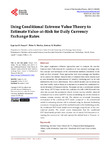Using Conditional Extreme Value Theory to Estimate Value-at-Risk for Daily Currency Exchange Rates

View/
Date
2017Author
Omari, Cyprian O.
Mwita, Peter N.
Waititu, Antony G
Metadata
Show full item recordAbstract
This paper implements different approaches used to compute the one-day
Value-at-Risk (VaR) forecast for a portfolio of four currency exchange rates.
The concepts and techniques of the conventional methods considered in the
study are first reviewed. These approaches have shortcomings and therefore
fail to capture the stylized characteristics of financial time series returns such
as; non-normality, the phenomenon of volatility clustering and the fat tails
exhibited by the return distribution. The GARCH models and its extensions
have been widely used in financial econometrics to model the conditional volatility dynamics of financial returns. The paper utilizes a conditional extreme
value theory (EVT) based model that combines the GJR-GARCH model that
takes into account the asymmetric shocks in time-varying volatility observed
in financial return series and EVT focuses on modeling the tail distribution to
estimate extreme currency tail risk. The relative out-of-sample forecasting
performance of the conditional-EVT model compared to the conventional
models in estimating extreme risk is evaluated using the dynamic backtesting
procedures. Comparing each of the methods based on the backtesting results,
the conditional EVT-based model overwhelmingly outperforms all the conventional models. The overall results demonstrate that the conditional
EVT-based model provides more accurate out-of-sample VaR forecasts in estimating the currency tail risk and captures the stylized facts of financial returns
